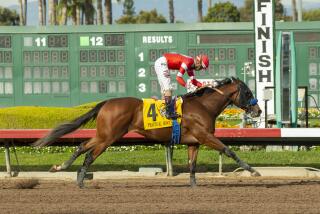Spend a Buck’s Fitness Concerns His Owner
- Share via
PITTSBURGH — It is hard for Dennis Diaz to watch video tape replays of Spend a Buck’s upset loss to 35-1 longshot Skip Trial in the Haskell Invitational Handicap at Monmouth Park.
It is not the loss that bothers Diaz so much as the way his game little multimillionaire colt struggled in obvious discomfort to hold on to second place.
“This is a real low for us now,” Diaz said a few days after the July 27 race. “Looking at the films, you could tell at the eighth pole he turned his head to the right. That means he was gasping. He couldn’t breathe.”
He couldn’t run very well either. His fractions of :23 2-5, :47, 1:10 45 and 1:35 4-5--good for other horses--were bad for the speedster who won four straight races by a total of 25 1-4 lengths.
Because Skip Trial took the lead just after the eighth pole, there was no clock on Spend a Buck’s final furlong. For the soft-hearted Diaz, that was just as well; the numbers may have broken his soft heart.
Both the fade and the involuntary effort by the colt to get more air were signals that something was wrong with Spend a Buck. And, sure enough, shortly after the race, Spend a Buck began to bleed from the nose.
Spend a Buck’s home-farm veterinarian, Dr. Robert O’Neil, was on hand to take a look at the colt. His evaluation included great news, semi-good news and not-so-good news.
The great news was that O’Neil found no signs of bone or soft-tissue damage.
The semi-good news was his conclusion that Spend a Buck had ruptured a blood vessel in the lungs, probably because of exhaustion. The track was dry and tiring; Spend a Buck was running off a two-month layoff that may have left him unprepared for the pressures of competition, and veterinarians have learned over the years that bleeding due to vascular ruptures in the lung is a fairly common physiological response to that kind of stress.
The bad news was left unsaid. Though in racing just a couple years, Diaz already knew the few facts available on the equine bleeding syndrome: he learned them when Spend a Buck bled after winning the Garden State Stakes, his last race before his wire-to-wire Kentucky Derby victory.
“A lot of horses bleed (some experts estimate the percentage of bleeders among race horses as high as 75 percent), and it doesn’t mean much,” said Dr. Wayne McIlwraith, the veterinary orthopedist from Colorado State University who performed arthoscopic knee surgery on Spend a Buck a year ago.
“We don’t know much at all about the cause or effect of bleeding. What we do know that it compromises his performance to a certain degree.”
O’Neil said: “If it was simply caused by him being tired, which we think it was, then it isn’t any problem at all.”
But Diaz is haunted by the possibility that Spend a Buck will suffer more pain--and perhaps damage--if he bleeds again. It is that worry that has him vacillating on whether to run the colt in the Aug. 17 Travers at Saratoga, the major summertime race for 3-year-olds.
“If it’s a deep, laboring track at Saratoga instead of just a fast track, we can’t run,” Diaz said. “We’d be crazy. We can’t let him get out there, and run like that and run out of air and bleed or maybe break down. And he’d do that, because he won’t quit.”
Though veterinarians can offer no scientific proof that such a possibility exists, McIlwraith is glad Diaz worries that way about his superstar patient.
“That’s probably the number one problem with being a vet: the horses can’t tell you anything,” McIlwraith said. “For that reason, you’re dependent on owners and trainers. Dennis talks to me all the time. He says to me, ‘Should we run? Should we not run? I want to do whatever is right for the horse.’
“All owners say those kinds of things,” McIlwraith added. “Some mean it, some don’t. Dennis has always been very sincere. He cares very much about the horse.”
More to Read
Go beyond the scoreboard
Get the latest on L.A.'s teams in the daily Sports Report newsletter.
You may occasionally receive promotional content from the Los Angeles Times.









